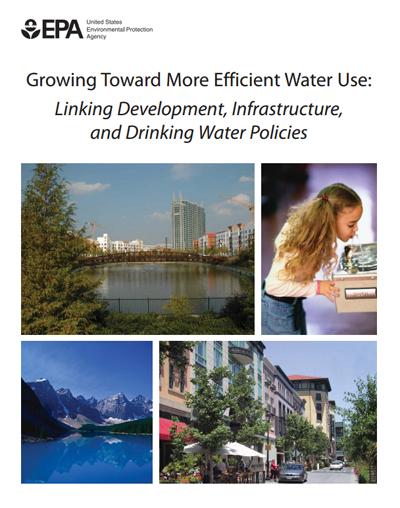
Linking Development, Infrastructure, and Drinking Water Policies
Growth affects water infrastructure costs, demand for water, and the efficiency of water delivery. This relationship is dynamic: water policies influence growth decisions and outcomes, which in turn affect infrastructure and water resources. Growing Toward More Efficient Water Use (2006) focuses on the nexus between water and growth.
- Part I of the report summarizes the challenges of meeting demand for safe drinking water.
- Part II discusses accommodating growth while minimizing its effects on water consumption and distribution costs.
- Part III explores water policies that can support this type of growth.
Some characteristics of conventional development can increase the cost of delivering water:
- Commercial facilities and homes on large lots often consume large quantities of water to irrigate lawns and landscaping.
- Low-density, dispersed development requires longer pipes, which lose more water through leakage and raise transmission costs.
- Infrastructure investments to expand water systems to dispersed development, rather than upgrade and maintain existing networks, can lead to inefficient systems with more waste and higher capital and operating costs.
Communities can significantly reduce water cost and demand by applying smart growth strategies. Compact development requires shorter transmission systems that are more efficient to operate and less susceptible to water loss through leakage. Encouraging compact neighborhood design using smaller lots reduces water demand for landscaping. Directing development toward areas served by existing infrastructure—and maintaining that infrastructure—makes systems more efficient.
State and local governments and utilities can adopt policies to conserve and reduce demand for water while supporting smarter growth patterns. Public advisory boards can help governments and utilities choose the best policies for local conditions. Policy options include:
• Fixing and upgrading existing infrastructure.
• Setting prices for water to reflect its full cost.
• Better coordinating water and land use planning.
• Innovative water financing.
• Encouraging water-saving landscaping.
The report provides examples of places that have implemented these policies to inform the choices of other areas.
Find more resources on smart growth and water.
You may need a PDF reader to view some of the files on this page. See EPA’s About PDF page to learn more.- Growing Toward More Efficient Water Use (PDF)(39 pp, 435 K)
